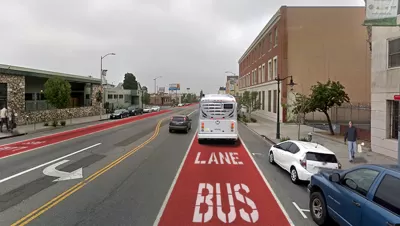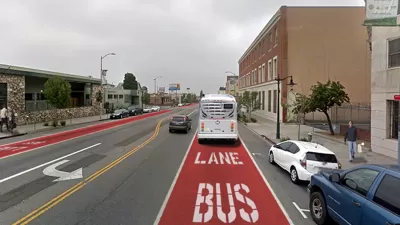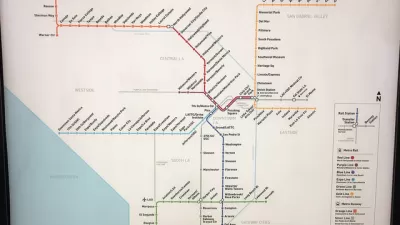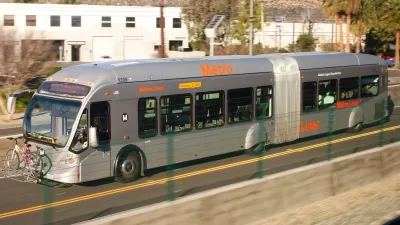Anyone hoping for rail transit down one of Los Angeles' busiest transit corridors will have to wait awhile.

When Los Angeles voters approved Measure M in 2016, they provided some funding for a planned bus rapid transit (BRT) route down 12.4 miles of the very busy Vermont Avenue corridor. That project is scheduled to begin in 2024 and open by 2028, if complete funding construction is acquired before then.
Now, however, the Los Angeles County Metropolitan Transportation Authority (Metro) is making plans to turn that BRT project into a light rail route in the very distant future.
"A report to be given this week to the Metro Board's Planning and Programming sheds light on how an as-of-yet unbuilt bus rapid transit line on Vermont Avenue could be converted into a rail line in the distant year of 2067," reports Steven Sharp.
The report studies rail transit as an option and comes up with three options, explains Sharp:
- Center-running light rail transit - similar to the Blue Line - with below-grade between operations between Wilshire/Vermont Station in Koreatown and Gage Avenue, where trains would proceed to an at-grade alignment within a wide center median to 120th Street;
- An extension of the Red Line starting at the corner of Vermont and 3rd Street, continuing south in a fully below-grade alignment to 120th Street; and
- A standalone heavy rail line starting at Wilshire/Vermont Station and proceeding below-grade to 120th Street.
In current construction costs, these projects would require between $4.4 billion on the cheap end and $8.4 billion on the expensive end. In 2067 costs, that would be $21.1 billion and $34.7 billion.
The largest impediment to any new transit on Vermont Avenue is funding, according to Sharp. Even the BRT project only has $25 million in funding from the Measure M total.
For insight into the importance of Vermont Avenue in the Los Angeles regional transit system, see an opinion written by Alon Levy in early 2018.
FULL STORY: Study Explores How Metro Could Convert the Proposed Vermont BRT Line to Rail

Alabama: Trump Terminates Settlements for Black Communities Harmed By Raw Sewage
Trump deemed the landmark civil rights agreement “illegal DEI and environmental justice policy.”

Study: Maui’s Plan to Convert Vacation Rentals to Long-Term Housing Could Cause Nearly $1 Billion Economic Loss
The plan would reduce visitor accommodation by 25% resulting in 1,900 jobs lost.

Why Should We Subsidize Public Transportation?
Many public transit agencies face financial stress due to rising costs, declining fare revenue, and declining subsidies. Transit advocates must provide a strong business case for increasing public transit funding.

Paris Bike Boom Leads to Steep Drop in Air Pollution
The French city’s air quality has improved dramatically in the past 20 years, coinciding with a growth in cycling.

Why Housing Costs More to Build in California Than in Texas
Hard costs like labor and materials combined with ‘soft’ costs such as permitting make building in the San Francisco Bay Area almost three times as costly as in Texas cities.

San Diego County Sees a Rise in Urban Coyotes
San Diego County experiences a rise in urban coyotes, as sightings become prevalent throughout its urban neighbourhoods and surrounding areas.
Urban Design for Planners 1: Software Tools
This six-course series explores essential urban design concepts using open source software and equips planners with the tools they need to participate fully in the urban design process.
Planning for Universal Design
Learn the tools for implementing Universal Design in planning regulations.
Smith Gee Studio
Alamo Area Metropolitan Planning Organization
City of Santa Clarita
Institute for Housing and Urban Development Studies (IHS)
City of Grandview
Harvard GSD Executive Education
Toledo-Lucas County Plan Commissions
Salt Lake City
NYU Wagner Graduate School of Public Service





























